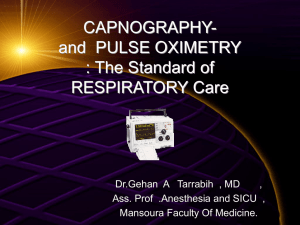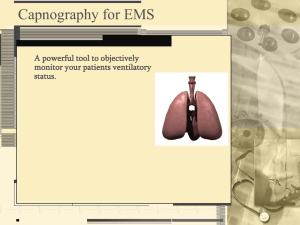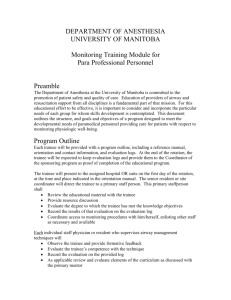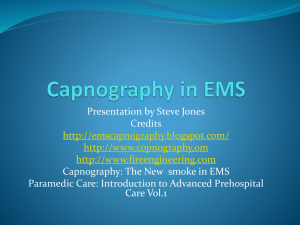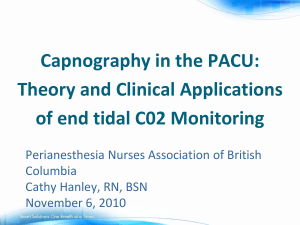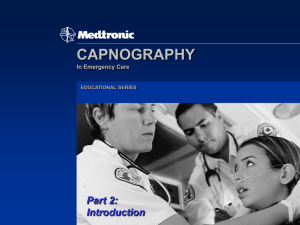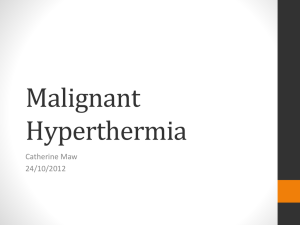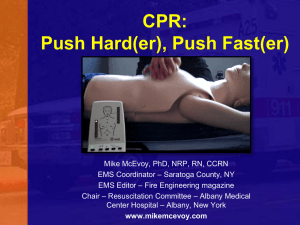1. Which patient would be a good candidate for EtCO2 monitoring?
advertisement
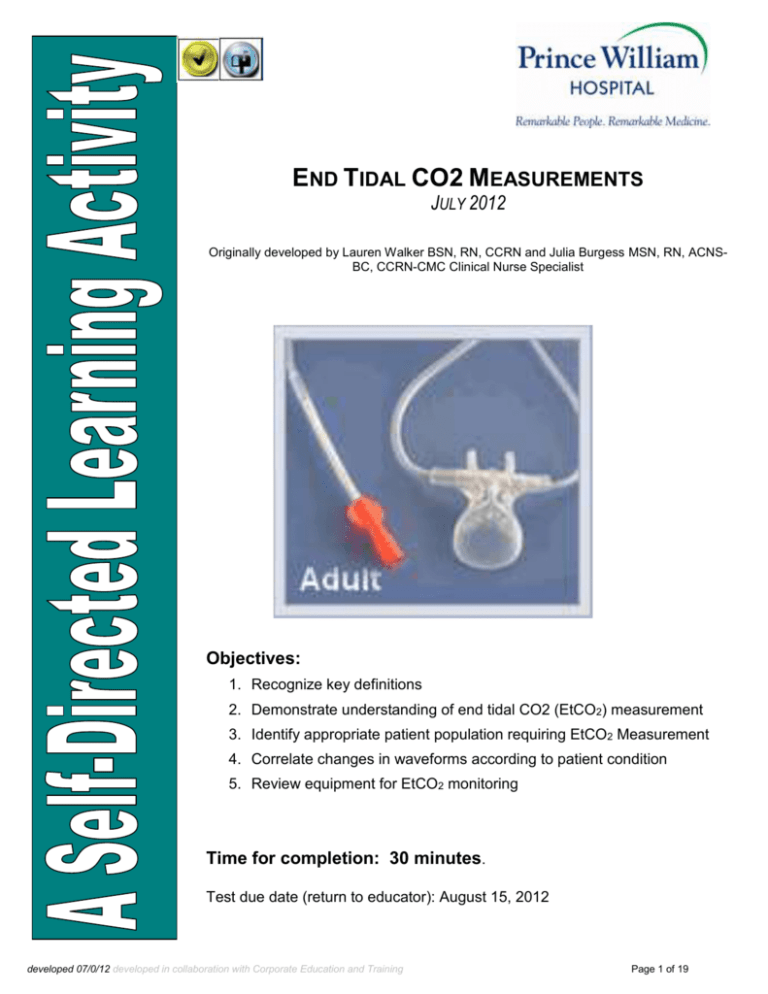
END TIDAL CO2 MEASUREMENTS JULY 2012 Originally developed by Lauren Walker BSN, RN, CCRN and Julia Burgess MSN, RN, ACNSBC, CCRN-CMC Clinical Nurse Specialist Objectives: 1. Recognize key definitions 2. Demonstrate understanding of end tidal CO2 (EtCO2) measurement 3. Identify appropriate patient population requiring EtCO2 Measurement 4. Correlate changes in waveforms according to patient condition 5. Review equipment for EtCO2 monitoring Time for completion: 30 minutes. Test due date (return to educator): August 15, 2012 developed 07/0/12 developed in collaboration with Corporate Education and Training Page 1 of 19 Table of Contents Instructions ........................................................................................................................................... 3 I. Capnography Review A. Definitions………..………………………………………………………………………………………….……………………4 B. Basic Pathology of the lungs……………………………………………………..…………………………………..5 C. Capnography….......………………………………………………………………………………………………………..……5 D. Clinical applications of EtCO2 in the ICU…………………………………..……………………………… 7 E. Applicable patients for EtCO2……………………………………………………………………………………….8 F. Normal Values…...……………………………………………………………………………………….……………………..8 G. Waveform Interpretation……………....……………………………………………………………………………9 H. Equipment……… I. Alarms……………………………………………………………………………………………………….……………………...16 II. Patient Education………………………...…………………………………………….………………………………………..16 III Post Test…………………..…………..…………………………………………………………………………………………………17 IV: References……………………………………………………………………………………………………………..………………..18 V: Evaluation……………………..……………………………………………………………………….……………………………………19 developed 07/0/12 developed in collaboration with Corporate Education and Training Page 2 of 19 Instructions This activity is designed for Registered Nurses in the acute care setting who care for patients recommended for EtCO2 monitoring. It serves to heighten awareness of the purpose of EtCO2 monitoring and the skill review for the nurse in interpreting waveform results. This packet serves as education in preparation for the roll out of EtCO2 monitoring in the Critical Care Unit. The approximate time for completion of this packet should be 30 minutes. This Self Learning Activity will refresh your knowledge of key definitions for oxygenation and ventilation, provide a review of the basic physiology of the lungs and capnography, include waveform interpretation and identify patients who could benefit from EtCO2 monitoring. This Self Learning Activity consists of three parts: (1) Educational Information (2) Post Test (3) Evaluation Please read the educational information and answer the post test. Document completion of this SLA on your annual continuing education record and give the post test to your manager or clinical educator. Your feedback regarding this activity is important to us. You will find an evaluation form at the end of this activity. When you complete this form, please forward it to your Nursing Educator or Nursing Education Office. We will use your feedback when the time comes to make revisions to this activity. Thank you and we hope you find this activity helpful. developed 07/0/12 developed in collaboration with Corporate Education and Training Page 3 of 19 Definitions End Tidal CO2 (EtCO2) – Peak concentration of carbon dioxide occurring at the end of expiration. Normal EtCO2 value: 30 – 45 mmHg. Capngram: A graphical waveform display of carbon dioxide concentration over time. Capnometry: Continuous and non-invasive measurement and graphical display of EtCO2. There is a sample chamber/sensor placed for optimum evaluation of ventilation with a numeric display of carbon dioxide. Pulse Oximetry: The amount of oxygen on the hemoglobin molecule reflecting oxygenation. Normal value 93-100%. Can alert the care provider to the hypoxic patient but does not give adequate forewarning of impending hypoxia due to ventilatory depression. When the patient slows or stops their breathing, the pulse oximeter will not detect the change until the number of oxygen molecules on the hemoglobin has dropped. This takes more time, especially if the patient is receiving supplemental oxygen. developed 07/0/12 developed in collaboration with Corporate Education and Training Page 4 of 19 Capnography Basic Physiology of the Lungs: The lungs have two main functions: o to inhale oxygen into the body o to exhale carbon dioxide from the body In normal lungs, the amount of carbon dioxide exhaled is very close to the level of carbon dioxide in the blood. Oxygen is inhaled into the lungs and carried into the bloodstream to the cells. Carbon dioxide is then transported back from the cells via the bloodstream to the lungs and exhaled. The transport of O2 via the bloodstream to the cells is called oxygenation. The movement of air into and out of the lungs and exhaling of CO2 via the respiratory tract is called ventilation. Oxygenation is measured by monitoring arterial oxygen saturation (SpO2) in a patient’s blood. Pulse oximetry measures oxygenation and it is affected by motion, artifact, distal circulation, temperature, and supplemental oxygen use. Ventilation is measured by monitoring alveolar carbon dioxide (EtCO2) in a patient’s exhaled breath. Capnography measures ventilation and it is not affected by motion, artifact, distal circulation, temperature, or supplemental oxygen use. developed 07/0/12 developed in collaboration with Corporate Education and Training Page 5 of 19 In the last ten years ETCO2 monitoring, or capnography, has become the standard of care for anesthesia administration. The American Society of Anesthesiologists (ASA) has recently recommended that any patients receiving moderate or procedural sedation also be provided with ETCO2 monitoring. The practice of ETCO2 monitoring has been less widely used in the critical care setting, but has many useful applications. Capnography is a tool for non-invasively measuring the partial pressure of carbon dioxide at the end of exhalation and directly measures ventilatory performance of the lungs. Carbon dioxide, produced during aerobic metabolism, builds up in the tissues. It diffuses out of the cells, into the circulation and across the alveolar membrane during respiration. It is then excreted by exhalation. Poor ventilation, as a result of sedation, results in a build-up of CO2, which is recognized by the monitor. Patients have the ability to maintain adequate SpO2 levels for prolonged periods in the presence of hypoventilation and apnea, especially during the administration of supplemental oxygen. A decrease in oxygen saturation, as reflected in a drop in the SpO2 displayed by the monitor, is a late indicator of hypoventilation and apnea. EtCO2 monitoring gives an accurate picture of the patient’s ventilatory status. A normal value is 35 - 45 mmHg and provides breath-to-breath information. Recent studies have shown that the use of capnography improves patient outcomes by providing early warning signs of hypoventilation, apnea, and airway obstruction, thus preventing hypoxic events. developed 07/0/12 developed in collaboration with Corporate Education and Training Page 6 of 19 Clinical Applications for the use of EtCO2 in the Intensive Care Unit To confirm proper placement of an advanced airway Monitor the quality of compressions during CPR o EtCO2 drops during cardiac arrest o A sudden rise in EtCO2 during CPR indicates a return of spontaneous circulation o EtCO2 of 20 mmHg should be maintained during CPR. o A drop may indicate fatigue by the person performing compressions and a need to change rescuers. Monitor the respirations in patients at risk for respiratory depression due to recent sedation, narcotics, or respiratory compromise o The amount of sedation required by a patient is variable; it depends on patient’s physiology and ability to use and metabolize the medication o Intermittent nurse monitoring of postoperative patients may not pick up on ventilatory depression Monitor respirations in patients with sleep apnea Assist with successful ventilator weaning Identify loss of advanced airway during long-term mechanical ventilation in the inpatient setting developed 07/0/12 developed in collaboration with Corporate Education and Training Page 7 of 19 Intensive Care Unit Patient’s who could benefit from the use of EtCO2 Non-Intubated: High risk for respiratory depression either from recent anesthesia or sedation Receiving IV opiates or narcotics for pain control such as those on PCA pump Respiratory conditions that are at a higher risk for compromise such as COPD or asthma Obstructive Sleep Apnea Intubated: Weaning from mechanical ventilation Sedation management Confirmation of ETT placement Predicting survival in cardiopulmonary resuscitation Trends in EtCO2 correlate with changes in the PaCO2 and can provide an early warning of metabolic or cardiorespiratory problems such as shunting, dead space, bronchoconstriction or pulmonary embolism. Normal Values Normal PaCO2 from an ABG sample is 35 – 45 mmHg Normal EtCO2 is between 30 – 45 mmHg EtCO2 under normal conditions can be 2 to 5 mmHg lower than an arterial PaCO2 on an arterial blood gas sample. Fractional Inspired Carbon Dioxide (FiCO2) is 0 mmHg; This is the “0” baseline on the capnogram Adult respiratory rate – 8 to 18 developed 07/0/12 developed in collaboration with Corporate Education and Training Page 8 of 19 EtCO2 Waveform Interpretation The capnographer displays each breath as a waveform in millimeters of mercury (mmHg) of CO2 as a function of time, and provides a continuous reading for the carbon dioxide level. It also displays a numeric value for the CO2 level at the end of expiration. The capnogram, or EtCO2 waveform, is a visual assessment of the patient airway integrity. Waveforms have characteristic shape like an ECG. The evolution of CO2 from the alveoli to the mouth during exhalation, and inhalation of O2 free gases during inspiration gives the characteristic shape to the CO2 curve. On the EtCO2 waveform: Height shows the amount of exhaled carbon dioxide Length depicts time Shape of a capnogram is identical in all patients with healthy lungs Any deviations in shape must be investigated to determine a cause of the abnormality. Capnography Waveforms: Wave Wave Wave Wave 1: Exhalation begins; air from the anatomic dead space has cleared 2: Alveolar air mixes with atmospheric air and ETCO2 rises rapidly 3: A exhalation proceeds, the CO2 waveform levels, air is primarily alveolar 4: As inspiration occurs, atmospheric air rushes in, CO2 levels fall to zero developed 07/0/12 developed in collaboration with Corporate Education and Training Page 9 of 19 Normal ETCO2 Waveform: The normal waveform values are 30-45 Hyperventilation Waveform: In hyperventilation the waveforms starts out normal and then as the rate of respirations increases the waves become closer together and value of the CO2 decreases. Clinical findings: Rapid breathing, low EtCO2 developed 07/0/12 developed in collaboration with Corporate Education and Training Page 10 of 19 Hypoventilation Waveform: The waveform looks normal but the value of the CO2 begins to rise as the patient’s breathing becomes less effective, usually due to a narcotic overdose, CNS depression, or heavy sedation, and they are not exhaling all of their CO2. Clinical findings: Slow breathing, high EtCO2 Bronchoconstriction Waveform: The shark fin appearance of the waveform indicates a possible airway constriction as seen in poor head and neck alignment, asthma, COPD exacerbation or partial airway obstruction. Clinical Findings: Possible irregular breathing, snoring or audible breathing developed 07/0/12 developed in collaboration with Corporate Education and Training Page 11 of 19 Apnea or loss of the waveform: In the spontaneously breathing patient this could be a sign of respiratory arrest. If the patient is breathing it could indicate a equipment defect. If the patient is intubated it could indicate an obstruction. Always assess the patient. Clinical findings: Very shallow of no respiratory rate pattern, sudden loss of EtCo2 reading Esophageal Intubation Waveform: When the ETT is incorrectly placed in esophagus the waveforms are either small and transient or completely flat developed 07/0/12 developed in collaboration with Corporate Education and Training Page 12 of 19 EtCO2 Waveform during CPR: Waveform capnography allows providers to monitor CPR quality, optimize chest compressions and detect a return of spontaneous circulation during chest compressions. If the EtCO2 is less than 10 mmHg, attempt to improve quality of compressions A sudden increase in EtCO2 during CPR indicates a return of spontaneous circulation developed 07/0/12 developed in collaboration with Corporate Education and Training Page 13 of 19 EtCO2 Equipment and Devices Mainstream: CO2 sensors are located directly in the patient’s breathing circuit. Sidestream: Remote from the patient as part of CO2 monitoring system Inline adaptor for patients on mechanical intubation: Microstream CapnoLine that has a nasal cannula with CO2 detector: developed 07/0/12 developed in collaboration with Corporate Education and Training Page 14 of 19 Adaptor that attaches to central monitor. The EtCO2 cord will attach to the adaptor and display a waveform on the central monitor: EtCO2 waveform on central monitor: developed 07/0/12 developed in collaboration with Corporate Education and Training Page 15 of 19 EtCO2 Alarms Low EtCO2 Alarm: possible causes include a true measurement, disposable not correctly attached to a patient High EtCO2 Alarm: Possible causes include a true measurement, fever or hypermetabolic state, disposable not currently attached to patient High FiCO2 Alarm: Possible causes include the patient is inspiring exhaled CO2, disposable not correctly attached to patient, oxygen flow to mask may have stopped, covers may be over patient’s face No Breath Detected Alarm: Possible causes include patient is not breathing, disposable not correctly attached to patient and/or device, disposable not detecting exhaled breath (shallow breath) Patient Education: As with every intervention, patients must be educated to the purpose, potential side effects of whatever intervention that is prescribed for the patient. Patients and family should be educated about the following: Purpose of monitoring CO2 Importance of monitor alarm Activity restriction, if any developed 07/0/12 developed in collaboration with Corporate Education and Training Page 16 of 19 EtCO2 Post Test 1. Which patient would be a good candidate for EtCO2 monitoring? A. 25 year old female s/p central venous line placement with two doses of lidocaine B. 59 year old mechanically vented male on sedation s/p bronchosopy C. 78 year old male on bipap with orders for comfort measures D. 66 year old female with obstructive sleep apnea s/p cardiac cath 2. Identify the waveform below: A. Normal B. Hypoventilation C. Hyperventilation D. Apnea 3. Your patient is in cardiac arrest and CPR is initiated. EtCO 2 is also being monitored during chest compressions. The team leader tells you that the EtCO 2 is 12 mmHg. What is your next action? A. Continue chest compressions at the same rate, an EtCO2 above 10 mmHg indicates good quality chest compressions. B. Increase the quality of chest compressions, EtCO2 below 30 mmHg indicates poor quality compressions. C. Decrease the intensity of the chest compressions, EtCO 2 below 10 mmHg indicates chest compressions that are too intense in quality. D. Stop chest compressions, the patient has a ROSC. 4. Capnography or ETCO2 measures: A. Oxygenation B. Ventilation C. Perfusion D. AA Gradient 5. True or False. EtCO2 can be used on intubated and non-intubated patients. A. True B. False developed 07/0/12 developed in collaboration with Corporate Education and Training Page 17 of 19 References American Heart Association. (2012). Waveform capnography. Retrieved June 28, 2012, from http://acls-algorithms.com/waveform-capnography Good, V., & Luehrs, P. (2010). Continuous end-tidal carbon dioxide monitoring. AACN procedure manual for critical care (5th ed., pp. 105-111). St Louis: Saunders. Kraft, K. (2011). Using capnography to improve patient safety. Unpublished manuscript. Marini, J., & Wheeler, A. (2010). Critical care medicine, the essentials. Philadelphia: Lippincott Williams & Wilkins. Marino, P. (2009). The little ICU book. Philadelphia: Lippincott Williams & Wilkins. Nikolova-Todorova, Z. (2008). Clinical applicaitons to capnography. SIGNA VITAE, 3(1), S44-S45. St. John, R. (2003). End-tidal carbon dioxide monitoring: Protocols for practice. Critical Care Nurse, 23(4): 83-88. developed 07/0/12 developed in collaboration with Corporate Education and Training Page 18 of 19 Test Answers: D,B, A, B, A EVALUATION Title of Activity: ETCO2 MONITORING Date: We are interested in your evaluation of this activity. Your feedback is important in planning future self-learning activities. Strongly Agree Agree Disagree Strongly Disagree A. Overall I am satisfied with this self-directed learning activity. B. Objectives I have specific ideas I can apply to my job/ career goals. Self-directed learning activity objectives were met. 1. The following individual objectives were met: Demonstrate understanding of EtCO2 monitoring. Enhance ability to communicate patients at risk for respiratory depression and would benefit from EtCO2 monitoring Demonstrate assessment of patients based on scope of practice. Discuss the normal ETCO2 waveform 1. Materials and Methods This SLA was easy to understand This SLA held my interest This SLA was organized and easy to use. 2. How could this SLA be improved? (Please comment if you selected “Disagree” or “Strongly Disagree” for any of the above sections.) F. What aspects of this SLA were helpful? G. What did you learn that you plan to use in your work setting? Please return this form via interoffice mail addressed to CCU CCNS developed 07/0/12 developed in collaboration with Corporate Education and Training Page 19 of 19 NA
